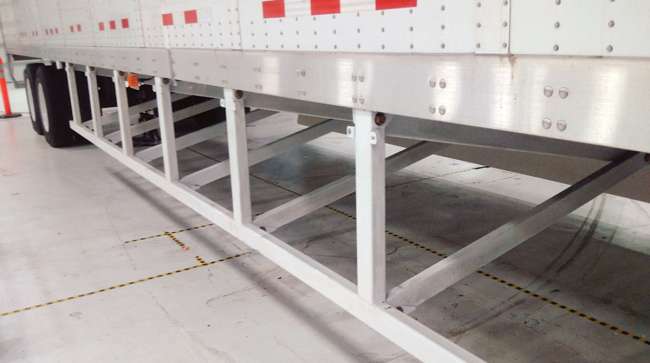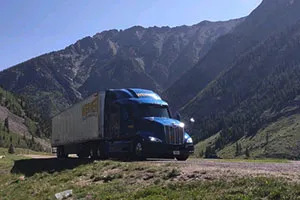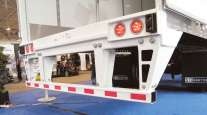Senior Reporter
Truckers Largely Oppose Side Underride Guard Proposed Rule

[Stay on top of transportation news: Get TTNews in your inbox.]
Truckers to regulators: A proposal to require side underride guards on heavy trucks is not ready for prime time.
As the first round of written comments closed July 20 on an Advance Notice of Proposed Rulemaking, it was becoming clear that truckers believe the National Highway Transportation Safety Administration must conduct more research, data collection and real-world testing to convince industry that a regulatory side underride mandate is a good idea, or even if the costs are worth the benefits.
About 2,000 parties filed comments on the proposal, ranging from trucking, trailer and owner-operator trade groups to bicycle riders and safety nonprofits.
Here’s an excerpt from American Trucking Associations on the proposal, which the group does not support:
ATA believes that efforts to decrease and eliminate side underride crashes should be focused on preventing the crash from occurring in the first place.
American Trucking Associations
“ATA policy is that equipment requirements should be based on sound engineering and economic principles that enhance safety, take into account real-world operations and weigh potential unintended consequences,” the trade organization wrote. “Side underride guards are approximately 40 feet long [rear guards are only about 8 feet long] and would be subjected to a wide variety of crash scenarios, but only have limited testing data on one specific scenario. ATA believes that efforts to decrease and eliminate side underride crashes should be focused on preventing the crash from occurring in the first place.”
The American Truck Dealers division of the National Automobile Dealers Association wrote, “NHTSA made appropriate use of, and drew reasonable conclusions from, the limited available data and research. However, proceeding with a side underride mandate based on this incomplete information and testing that does not replicate realistic highway conditions is premature and untenable.”
The Truckload Carriers Association said it was “disappointed that NHTSA has proceeded with this notice when the market has such limited options available to an industry that is far and away the leading mode of freight delivery in this nation.”
TCA added, “Any rulemaking, bestowed upon this industry, must be based on sound engineering principles, and include rigorous testing and research, things that have not yet been done. TCA questions the lack of testing and research committed to a device with one manufacturer and limited trials.”
The Truck Trailer Manufacturers Association agreed.
“Before deploying any potential safety device, it is imperative that the manufacturer and others ensure that it has undergone thorough testing for safety and effectiveness, and also that the effect in the real world is both safe and well understood.”
“Although the ANPRM did not directly ask this, it is important to note that trailers come in a vast multitude of designs such as dry bulk, low-boys, gasoline tankers, etc.,” TTMA added. “Some trailers are designed to operate with equipment under them, or go off-road such as grain and agricultural trailers. As far as TTMA is aware, commercially available side underride designs only exist for box-type trailer designs, and no device has yet been developed for the multitude of other designs.”

A Werner truck on the road in Copper Mountain, Colo. (Werner Enterprises via Twitter)
Likewise, Werner Enterprises Inc. wrote that it has “overriding concerns” about the potential for unintended safety and operational consequences, the net negative annual benefit calculated by NHTSA and additional costs.
“Werner notes the numerous technical challenges posed by adding weight to trailers, including possible increases in fuel consumption and emissions, as well as difficulty in making high-grade railroad crossings and completing certain docking tasks, which may hang up or damage cargo and create safety hazards for other motorists, train operators, train passengers and dockworkers,” the company said.
Werner ranks No. 17 on the Transport Topics Top 100 list of the largest for-hire carriers in North America.

How effective have third-party services proved to be for fleets? Let's find out with Michael Precia of Fleetworthy Solutions and Dan Rutherford with Summit Virtual CFO by Anders. Tune in above or by going to RoadSigns.ttnews.com.
“The Owner-Operator Independent Drivers Association opposes efforts that would mandate the installation of side underride guards on commercial motor vehicles, CMV trailers and semitrailers,” the trade association wrote. “Over the last several years, NHTSA has considered numerous options involving side underride guards, but has consistently concluded a federal mandate would be impractical and costly, thus outweighing possible safety benefits.
“Advancing any side underride mandate disregards this reality and ignores the safety, economic and operational concerns that have been raised by small-business truckers.”
The nonprofit Truck Safety Coalition said the public rightly views NHTSA’s commitment to reducing side underride crashes with skepticism.
“In analyzing the side underride guard ANPRM, it appears several subjective decisions were made in the analysis that artificially limits the estimated number of lives saved and fails to quantify the deadly impact of multigenerational side underride guard inaction,” the coalition wrote. “In addition, NHTSA did not conduct any robust side underride guard impact testing with real-world prototypes from multiple manufacturers to properly inform its analysis.”
Want more news? Listen to today's daily briefing below or go here for more info:




